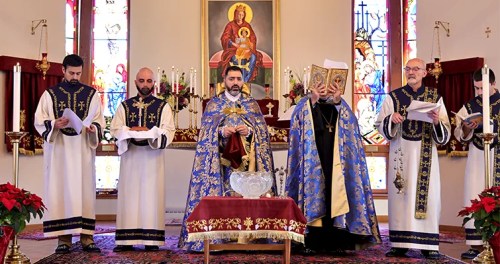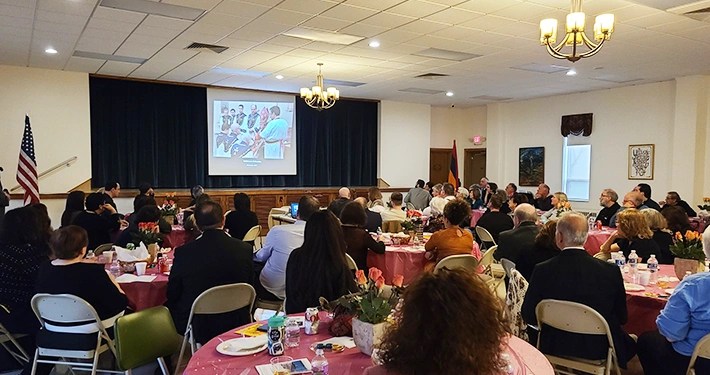By David Luhrssen
On Sunday, November 9, 2025, Bishop Mesrop Parsamyan, Primate of the Eastern Diocese, visited Milwaukee to celebrate the 83rd anniversary of St. John the Baptist Armenian Orthodox Church. During the Divine Liturgy (Badarak), Bishop Mesrop—assisted by Rev. Fr. Guregh Hambardzumyan, pastor; Fr. Nareg, former pastor; and Deacon Sarkis Ginosyan, a seminarian from St. Nersess Seminary—ordained Arek Kashian, Michael Kashian, and David Luhrssen to the diaconate, and conferred the rank of t’bir (Acolyte) upon Eric Kashian—a milestone in the parish’s ongoing efforts to prepare and strengthen its future leaders.
In his sermon, Bishop Mesrop reflected on the vital importance of community, contrasting the biblical model of shared faith and the common good with the self-focused, often unfulfilling “spirituality” of contemporary society. He drew an analogy to the redwood trees of California, noting that these towering giants have endured for centuries not because they stand alone, but because their roots are deeply intertwined, supporting and sustaining one another. Similarly, he emphasized, the Church thrives when its members are united in faith, love, and service.
The celebration continued in the church’s Cultural Hall, beautifully redesigned for the occasion by Sandy and Jim Densmore. The program began with the singing of “Mer Hairenik,” the Armenian national anthem, and “God Bless America,” followed by the Primate’s invocation. Parish Council Chairman Lyle Dadian emceed a program featuring a rich array of presentations and performances. Highlights included a slide show (featuring photos by Don Rask) capturing memorable moments from the parish’s past five years, a video presentation of St. John and Milwaukee that premiered at the 2025 Diocesan Assembly, and a spirited performance by the Hamazkayin Sardarabad Dance Ensemble of Chicago.
The newly ordained deacon David Luhrssen offered a heartfelt toast during the anniversary luncheon, wishing the St. John community continued success for many years to come. When asked what first brought him to the parish and what inspired him to remain active—serving at the altar, on the parish council, as a parish delegate, and in many other leadership roles—he shared his story with the nearly 150 guests attending the program.
He recalled that it was after the 1988 earthquake in Armenia that he first attended a service at St. John—just two years after the consecration of the new sanctuary in 1986. Having never been to an Armenian church before, he was deeply moved by the service led by Father Tateos Abdalian, with Father Nareg (then a deacon) and the late Deacon Samuel Avakian serving at the altar, accompanied by a full and beautiful choir and an accomplished organist, Jan Avakian Kopatich. Most importantly, he emphasized that it was the genuine warmth, welcome, and friendship of the St. John community that inspired him to return, get involved, and ultimately become an integral part of the parish family.
This year’s Diane Blinka Service Award for devoted service to the St. John community was presented to Gail Gabrelian and Deann Kokott. The late Diane Blinka exemplified true selflessness, devotion, commitment, and many years of dedicated service to the parish. The day’s most joyful surprise came with the reading of an encyclical from His Holiness Karekin II, Catholicos of All Armenians, awarding the St. Nersess the Graceful Medal to Nancy and Dr. Gary Seabrook in recognition of their outstanding devotion and faithful service to the Church.
St. John’s parish priest, Rev. Fr. Guregh Hambardzumyan, likened the parish to the “good heart” of Milwaukee’s Armenian community—kept beating and strong through the dedication and contributions of all its members. Bishop Mesrop also shared reflections from his childhood in Soviet Armenia, recalling his first encounter with the Badarak at the historic Khor Virap Monastery at age 13. “The beauty caught my spirit,” he said. “Understanding the theology came later. The beauty is what stayed with me.” He honored the parish’s founders—survivors of the Armenian Genocide—who established St. John as a new home for their legacy in the New World. Looking ahead, Bishop Mesrop expressed his anticipation of returning when the parish hosts the Diocesan Assembly in May 2026.
Many honored guests attended the anniversary, including Oscar Tatosian, Honorary Consul of the Republic of Armenia, as well as the former pastor and other Armenian clergmen. The program concluded with the audience joining in the singing of the “Der Getso,” led by Fr. Nareg and accompanied on the piano throughout the Liturgy and program by Jan, followed by the Primate’s benediction.
The 83rd anniversary of St. John the Baptist Armenian Orthodox Church was not only a celebration of its rich history and enduring faith, but also a testament to the vibrant, close-knit community that has sustained it through generations. With a renewed commitment to service, fellowship, and Armenian heritage, the parish looks forward to many more years of spiritual growth, shared joy, and continued contributions to the life of Milwaukee’s Armenian community.








You must be logged in to post a comment.